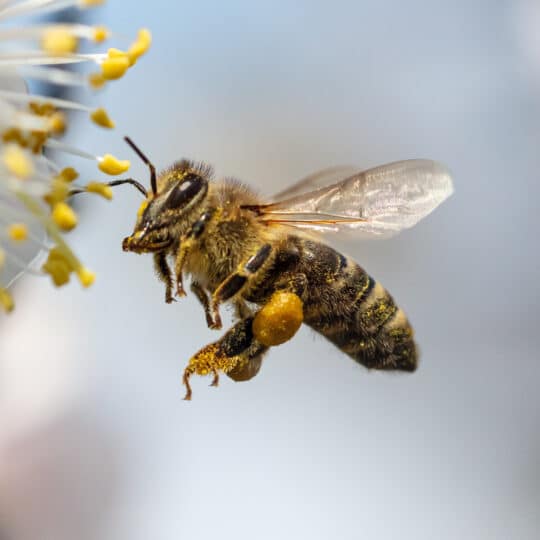Dealing with Stinging Insects this Spring
6 Types, 8 Tips, and an Insecticide Debate

Now that the weather is warming and flowers are budding, more insects are emerging, including ones that sting. Some species, like bees, may have been overwintering in your garden and are waking up hungry. Learn about the different types to watch for and the best ways of dealing with stinging insects this spring.
Types of Stinging Insects
While all stinging insects have the potential for stinging, not all are as harmful as you think. Here are some common species that may be buzzing around your lawn.
- Bees. Honey bees, bumblebees, and carpenter bees become more active in spring. Some are looking for food and will pollinate your garden, while others are looking to burrow into wooden areas to build their nest.
- Wasps. Paper wasps, yellow jackets, and hornets are also actively looking to regrow their colonies this spring. They can be more aggressive as they build nests and defend their territory.
- Yellow Jackets. They often build nests in the ground, walls, or other protected areas and are known for their aggressive behavior, especially in late summer and fall.
- Hornets. Larger than yellow jackets, they can be more aggressive when their nests are threatened.
- Cicada Killers. These large wasp-like insects travel alone as they hunt cicadas. They are more active in late spring and early summer.
- Mud Daubers. They are also solitary wasp-like insects that build nests out of mud around homes and buildings. They are more active in spring and early summer as they build nests and hunt for spiders to feed their larvae.
While some of these insects are more likely to sting if they’re provoked, it’s best to steer clear of them, especially if you’re allergic to their venom. One or two bees buzzing around your garden is a good thing, but if you see any hovering around your home, entering under eaves, or building a nest, it’s best to take action.
Dealing with Stinging Insects this Spring
Don’t be surprised if you see more stinging insects emerging this spring. Also, don’t ignore the signs of a nest being constructed around your home. Here are some tips on how to deal.
- Take preventive action. You can help stop an infestation before it even starts with some simple home improvements. Seal cracks and crevices around your home to prevent any insect from entering. Keep food and drinks covered when outdoors so you don’t attract them. Also keep in mind that brightly colored clothing or decor and strong fragrances also attract these insects.
- Maintain your yard. You can keep insects out of your garden by trimming back bushes, trees, and shrubs. Keep your lawn well-maintained to reduce attractive weed growth. Remove standing water since it also attract thirsty insects.
- Use natural deterrents. Save yourself from having to apply chemicals around your home by planting certain herbs and essential oils like mint, citronella, and basil to help deter stinging insects.
- Properly identify the species. If you do spot some pests around your yard, it’s important to know which stinging insects you’re dealing with. Some are more harmful than others and each requires a slightly different approach to controlling.
- Stay calm. If you encounter a stinging insect indoors or out, avoid swatting at it. Instead, move slowly away from the area to reduce the risk of being stung. If you find one in your home, try opening the window to help guide it back out. If there’s more than one, call a professional for help.
- Protect yourself. When outdoors, especially in the garden, wear closed-toe shoes, long sleeves, and long pants to help protect yourself from stings. Consider using insect repellent for added protection.
- Stay vigilant. Be mindful of where stinging insects might build nests, such as in eaves, under decks, or in trees. Regularly inspect these areas and take action if you notice any nests forming.
- Call a professional. If you’re allergic to the stings or find a large nest near your home, it’s best to call a professional pest control service to handle the situation safely.
With some preventative care and alertness, you can help minimize the risk of encountering a stinging insect. However, if they end up swarming, there’s more you can do.
Reasons For and Against Insecticide
Some homeowners are quick to turn to chemicals when it comes to dealing with pests. Using insecticides around stinging insects has both pros and cons. Here’s a breakdown of why you should and shouldn’t use certain products in these situations:
- Some insecticides can quickly and effectively prevent or eliminate insects and their nests, reducing the risk of stings. Just be sure you use the right product to target the type of insect you’re dealing with.
- When used properly, some products are designed to be safe for use around humans and pets.
- Insecticides are readily available and simple enough for homeowners to address small infestations.
- Some insecticides can be harmful to the environment, including beneficial insects like bees and other pollinators.
- Improper use of insecticides can pose health risks to human and pets.
- Some stinging insects may not be effectively controlled by certain insecticides.
- There are alternative, more natural methods of controlling stinging insects, such as using traps or physical barriers.
Whether you decide to use a natural deterrent, insecticide, or call a professional, it’s best to weigh the benefits of control against the potential risks to your family and the environment. To stay on the safe side, contact Cardinal Pest at 614-808-4446 if you suspect you have a pest problem. Our specialists have the equipment and know-how to secure and restore an area before, during, and after a stinging insect infestation.